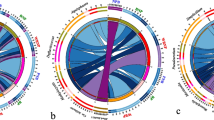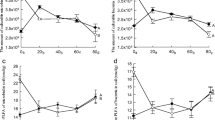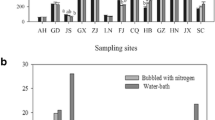Abstract
Purpose
For an alkaline–saline region in Northwest China, we examined the responses of soil microbial communities to flue gas desulfurization gypsum by-products (FGDB), a new ameliorant for alkaline–saline soils. In 2009 and 2010, we collected soils from 0–20 cm and 20–40 cm depths along an experimental FGDB gradient (0, 0.74, 1.49, 2.25, and 3.00 kg FGDB m−2).
Materials and methods
As a measure of microbial community composition and biomass, we analyzed phospholipid fatty acids (PLFAs). We used real-time quantitative polymerase chain reaction (qPCR) to measure abundance of bacterial 16 S rRNA copy numbers. Additionally, physicochemical soil parameters were measured by common laboratory methods.
Results and discussion
Microbial community composition differed along the FGDB gradient; however, the microbial parameters did not follow a linear response. We found that, in 2009, total PLFA concentrations, and concentrations of total bacterial and Gram-negative bacterial PLFAs were slightly higher at intermediate FGDB concentrations. In 2010, total PLFA concentrations, and concentrations of total bacterial, Gram-positive bacterial, Gram-negative bacterial, and fungal PLFAs as well as the fungal:bacterial PLFA ratio were highest at 1.49 kg FGDB m−2 and 3.00 kg FGDB m−2. PLFA concentrations often differed between 2009 and 2010; however, the patterns varied across the gradient and across microbial groups. For both years, PLFA concentrations were generally higher at 0–20 cm depth than at 20–40 cm depth. Similar results were obtained for the 16 S rRNA copy numbers of bacteria at 0–20 cm depth. FGDB addition resulted in an increase in soil Ca2+ and NO −3 –N and a decrease in pH and electrical conductivity (EC). Shifts in PLFA-based microbial community composition and biomass could partly be explained by pH, soil organic carbon, total nitrogen (TN), soil moisture, EC, inorganic nitrogen, C/N, and Ca2+. Indirect effects via shifts in abiotic soil properties, therefore, seem to be an important pathway through which FGDB affect soil microbial communities.
Conclusions
Our results demonstrate that addition of FGDB leads to significant changes in soil physicochemical and microbial parameters. As such, addition of FGDB can have large impacts on the functioning of soil ecosystems, such as carbon and nitrogen cycling processes.




Similar content being viewed by others

References
Aciego Pietri JC, Brookes PC (2009) Substrate inputs and pH as factors controlling microbial biomass, activity and community structure in an arable soil. Soil Biol Biochem 41:1396–1405
Amezketa E, Aragüés R, Gazol R (2005) Efficiency of sulfuric acid, mined gypsum, and two gypsum by-products in soil crusting prevention and sodic soil reclamation. Agron J 97:983–989
Bååth E, Anderson TH (2003) Comparison of soil fungal/bacterial ratios in a pH gradient using physiological and PLFA-based techniques. Soil Biol Biochem 35:955–963
Bardgett RD, Hobbs PJ, Frostegård Å (1996) Changes in soil fungal:bacteria biomass ratios following reductions in the intensity of management of an upland grassland. Biol Fertil Soils 22:261–264
Bardgett RD, Freeman C, Ostle NJ (2008) Microbial contributions to climate change through carbon cycle feedbacks. The ISME Journal 2:805–814
Bhatt J, Indirakutty K (1973) Salt uptake and salt tolerance by sunflower. Plant Soil 39:457–460
Bigham J, Dick W, Forster L, Hitzhusen F, McCov E, Stehouwer R, Traina S, Wolfe W (1993) Land application uses for dry FGD by-products, phase 1 report. Electric Power Research Institute, Palo Alto, California
Clark RB, Ritchey KD, Baligar VC (2001) Benefits and constraints for use of FGD products on agricultural land. Fuel 80:821–828
Chang AC, Lund LJ, Page AL, Warneke JE (1977) Physical properties of fly ash amended soils. J Environ Qual 6:267–270
Chen L, Dick WA, Nelson S (2001) Flue gas desulfurization by-products additions to acid soil: alfalfa productivity and environmental quality. Environ Pollut 114:161–168
Crews JT, Dick WA (1998) Liming acid forest soils with flue gas desulfurization by-product: growth of northern red oak and leachate water quality. Environ Pollut 103:55–61
Elgharably A, Marschner P (2011) Microbial activity and biomass and N and P availability in a saline sandy loam amended with inorganic N and lupin residues. Eur J Soil Biol 47:310–315
Fierer N, Schimel JP, Holden PA (2003) Variations in microbial community composition through two soil depth profiles. Soil Biol Biochem 35:167–176
Frostegård Å, Tunlid A, Bååth E (1991) Microbial biomass measured as total lipid phosphate in soils of different organic content. J Microbiol Meth 14:151–163
Frostegård Å, Bååth E (1996) The use of phospholipid fatty acid analysis to estimate bacterial and fungal biomass in soil. Biol Fertil Soils 22:59–65
Frostegård Å, Bååth E, Tunlio A (1993) Shifts in the structure of soil microbial communities in limed forests as revealed by phospholipid fatty acid analysis. Soil Biol Biochem 25:723–730
Frostegård Å, Tunlid A, Bååth E (1996) Changes in microbial community structure during long-term incubation in two soils experimentally contaminated with metals. Soil Biol Biochem 28:55–63
Frostegård Å (1995) Phospholipid fatty acid analysis to detect changes in soil microbial community structure. PhD thesis. Lund University, Sweden
Gaind S, Gaur AC (2003) Quality assessment of compost prepared from fly ash and crop residues. Bioresour Technol 87:125–127
Garau MA, Dalmau JL, Felipo MT (1991) Nitrogen mineralization in soil amended with sewage and fly ash. Water Sci Tech 12:199–201
Geisseler D, Horwath WR, Scow KM (2011) Soil moisture and plant residue addition interact in their effect on extracellular enzyme activity. Pedobiol 54:71–78
Gordon H, Haygarth PM, Bardgett RD (2008) Drying and rewetting effects on soil microbial community composition and nutrient leaching. Soil Biol Biochem 40:302–311
Grayston SJ, Griffith GS, Mawdsley JL, Campbell CD, Bardgett RD (2001) Accounting for variability in soil microbial communities of temperate upland grassland ecosystems. Soil Biol Biochem 33:533–551
Gray SB, Classen AT, Kardol P, Yermakov Z, Miller RM (2011) Multiple climate change factors interact to alter soil microbial community structure in an old-field ecosystem. Soil Biol Biochem 75:2217–2226
Grubb KL (2010) Utilization of gypsum as a filter material in agricultural drainage ditches: impacts of land application on soil fertility conditions. PhD Thesis. University of Maryland, Chapter 5(31)
Harris RF (1981) Water potential as a selective factor in the microbial ecology of soils. In: Parr JF, Gardner WR, Elliott LF (eds) Water potential relations in soil microbiology. Soil Science Society of America, Madison, WI, pp 141–151
He JZ, Shen JP, Zhang LM, Zhu YG, Zheng YM, Xu MG, Di HJ (2007) Quantitative analyses of the abundance and composition of ammonia-oxidizing bacteria and ammonia-oxidizing archaea of a Chinese upland red soil under long-term fertilization practices. Environ Microbiol 9:2364–2374
Hedlund K (2002) Soil microbial community structure in relation to vegetation management on former agricultural land. Soil Biol Biochem 34:1299–1307
Huang JY, Yu HL, Sun ZJ, Zhang JH, He WS (2011) Effects of flue gas desulfurization gypsum and krilium addition on alkali soil and rice growth. Agri Res Arid Areas 29:70–74 (in Chinese)
Jiang LL, Han XG, Zhang GM, Kardol P (2010) The role of plant–soil feedbacks and land-use legacies in restoration of a temperate steppe in norhtern China. Ecol Res 25:1101–1111
Johnson D, Leake JR, Lee JA, Campbell CD (1998) Changes in soil microbial biomass and microbial activities in response to 7 years simulated pollutant nitrogen deposotion on a healthland and two grassland. Environ Pollut 103:239–250
Kardol P, Cornips NJ, Van Kempen MML, Bakx-Schotman JMT, Van der Putten WH (2007) Microbe-mediated plant–soil feedback causes historical contingency effects in plant community assembly. Ecol Monogr 77:142–167
Laperche V, Bigham JM (2002) Quantitative, chemical, and mineralogical characterization of flue gas desulfurization by-products. J Environ Qual 31:979–988
Langer U, Rinklebe J (2011) Priming effect after glucose amendment in two different soils evaluated by SIR- and PLFA-technique. Ecol Eng 37:465–473
Lane DJ (1991) 16 S/23S rRNA sequencing. In: Stackebrandt E, Goodfellow M (eds) Nucleic acid techniques in bacterial systematics. USA, New York, pp 115–175
Lee YB, Bigham JM, Dick WA, Jones F, Ramsier C (2007) Influence of soil pH and application rate on the oxidation of calcium sulfite derived from flue gas desulfurization. J Environ Qual 36:298
Lee YB, Bigham JM, Dick WA, Kim PJ (2008) Impact of flue gas desulfurization-calcium sulfite and gypsum on soil microbial activity and wheat growth. Soil Sci 173:534–543
Li FX, Yang J, Xu X, Yang JG, Zheng GQ, Nan NL (2011) Effect of applying desulphurizaion byproducts on microbial diversity in alkaline soil under potted sunflower. Soils 43:270–276 (in Chinese)
Marschner P, Kandeler E, Marschner B (2003) Structure and function of the soil microbial community in a long-term fertilizer experiment. Soil Biol Biochem 35:453–461
McKinley VI, Peacock AD, White DC (2005) Microbial community PLFA and PHB responses to ecosystem restoration in tallgrass prairie soils. Soil Biol Biochem 37:1946–1958
Metternicht GI, Zinck JA (2003) Remote sensing of soil salinity: potentials and constraints. Remote Sens Environ 85:1–20
Mutabaruka R, Hairiah GK, Cadisch G (2007) Microbial degradation of hydrolysable and condensed tannin polyphenol–protein complexes in soils from different land-use histories. Soil Biol Biochem 39:1479–1492
Murphy DV, Sparling GP, Fillery IRP (1998) Stratification of microbial biomass C and N and gross N mineralization with soil depth in two contrasting Western Australian agricultural soils. Australian J Soil Res 36:45–55
Pettersson M, Bååth E (2003) Temperature-dependent changes in the soil bacterial community in limed and unlimed soil. FEMS Microbiology Ecology 45:13–21
Qadir M, Oster J (2004) Crop and irrigation management strategies for saline-sodic soils and waters aimed at environmentally sustainable agriculture. Sci Tot Environ 323:1–19
Rayment G, Higginson F (1992) Australian laboratory handbook of soil and water chemical methods, Inkata Press Pty Ltd.
Rautaray SK, Ghosh BC, Mittra BN (2003) Effect of fly ash, organic wastes and chemical fertilizers on yield, nutrient uptake, heavy metal content and residual fertility in a rice-mustard cropping sequence under acid lateritic soils. Bioresource Technol 90:275–283
Rui YC, Wang SP, Xu ZH, Wang YF, Chen CR, Zhou XQ, Kang XM, Lu SB, Hu YG, Lin QY, Luo CY (2011) Warming and grazing affect soil labile carbon and nitrogen pools differently in an alpine meadow of the Qinghai-Tibet Plateau in China. J Soils Sediments 11:903–914
Sakai Y, Matsumoto S, Sadakata M (2004) Alkali soil reclamation with flue gas desulfurization gypsum in China and assessment of metal content in corn grains. Soil Sediment Contam 13:65–80
Sarathchandra SU, Ghani A, Yeates GW, Burch G, Cox NR (2001) Effect of nitrogen and phosphate fertilizers on microbial and nematode diversity in pasture soils. Soil Biol Biochem 33:953–964
Schutter ME, Fuhrmann JJ (2001) Soil microbial community responses to fly ash amendment as revealed by analyses of whole soils and bacterial isolates. Soil Biol Biochem 33:1947–1958
Seybold CJ, Herrick JE, Brejda JJ (1999) Soil resilience: a fundamental component of soil quality. Soil Sci 164:224–234
Sicardi M, Garcia-Prechac F, Frioni L (2004) Soil microbial indicators sensitive to land use conversion from pastures to commercial Eucalyptus grandis (Hill ex Maiden) plantations in Uruguay. Appl Soil Ecol 27:125–133
Siddaramappa R, McCarty GW, Wright RJ, Codling FE (1994) Mineralization and volatile loss of nitrogen from soils treated with coal combustion byproducts. Biol Fertil Soils 18:279–284
Sudha J, Dinesh G (2006) Fly ash as a soil ameliorant for improving crop production—a review. Bioresource Technol 97:1136–1147
Terman GL, Kilmer VJ, Hunt CM, Bucnanan W (1978) Fluidized bed boiler waste as a source of nutrients and lime. J Environ Qual 7:147–150
Wang B, Xiao GJ, Mao GL, Yue ZH, Xu X (2010) Effects of coal-fired flue gas desulfurated waste residue application on saline–alkali soil amelioration and oil-sunflower growth. Chin J Plant Ecol 34:1227–1235 (in Chinese)
Wardle DA (1998) Controls of temporal variability of the soil microbial biomass: a global-scale synthesis. Soil Biol Biochem 30:1627–1637
Wendell RR, Richey KD (1996) High-calcium flue gas desulfurization products reduce aluminum toxicity in an Appalachian soil. J Environ Qual 27:1401–1410
Wu YP, Ding N, Wang G, Xu JM, Brookes PC (2009a) Effects of different soil weights, storage times and extraction methods on soil phospholipid fatty acid analysis. Geoderma 150:171–178
Wu YP, Ma B, Zhou L, Wang HZ, Xu JM, Kemmitt S, Brookes PC (2009b) Changes in the soil microbial community structure with latitude in eastern China, based on phospholipid fatty acid analysis. Appl Soil Ecol 43:234–240
Xu ZH, Ward S, Chen CR, Blumfield T, Prasolova N, Liu JX (2008) Soil carbon and nutrient pools, microbial properties and gross nitrogen transformations in adjacent natural forest and hoop pine plantations of subtropical Australia. J Soils Sediments 8:99–105
Xu ZH, Chen CR, He JZ, Liu JX (2009) Trends and challenges in soil research 2009: linking global climate change to local long-term forest productivity. J Soils Sediments 9:83–88
Yao H, He Z, Wilson MJ, Campbell CD (2000) Microbial biomass and community structure in a sequence of soils with increasing fertility and changing land use. Microbial Ecol 40:223–237
Yuan BC, Li ZZ, Liu H, Gao M, Zhang YY (2007) Microbial biomass and activity in salt affected soils under arid conditions. Appl Soil Ecol 35:319–328
Zak DR, Ringelberg DB, White DC, Curtis PS (1996) Soil microbial communities beneath Populus grandidentata grown under elevated atmospheric CO2. Ecol Appl 6:257–262
Zahran H (1997) Diversity, adaptation and activity of the bacterial flora in saline environments. Biol Fertil Soils 25:211–223
Zelles L, Bai QY, Ma RX, Rackwitz R, Winter K, Beese F (1994) Microbial biomass, metabolic activity and nutritional status determined from fatty acid patterns and poly hydroxybutyrate in agriculturally managed soils. Soil Biol Biochem 26:439–446
Zhang NL, Wan SQ, Li LH, Bi J, Zhao MM, Ma KP (2008) Impacts of urea N addition on soil microbial community in a semi-arid temperate steppe in northern China. Plant Soil 311:19–28
Zogg GP, Zak DR, Ringelberg DB, MacDonald NW, Pregitzer KS, White DC (1997) Compositional and functional shifts in microbial communities due to soil warming. Soil Sci Soc Am J 61:475–481
Acknowledgments
This work is financially supported by the National Science Foundation of China (30870447).
Author information
Authors and Affiliations
Corresponding author
Additional information
Responsible editor: Hailong Wang
Rights and permissions
About this article
Cite this article
Li, M., Jiang, L., Sun, Z. et al. Effects of flue gas desulfurization gypsum by-products on microbial biomass and community structure in alkaline–saline soils. J Soils Sediments 12, 1040–1053 (2012). https://doi.org/10.1007/s11368-012-0531-z
Received:
Accepted:
Published:
Issue Date:
DOI: https://doi.org/10.1007/s11368-012-0531-z



